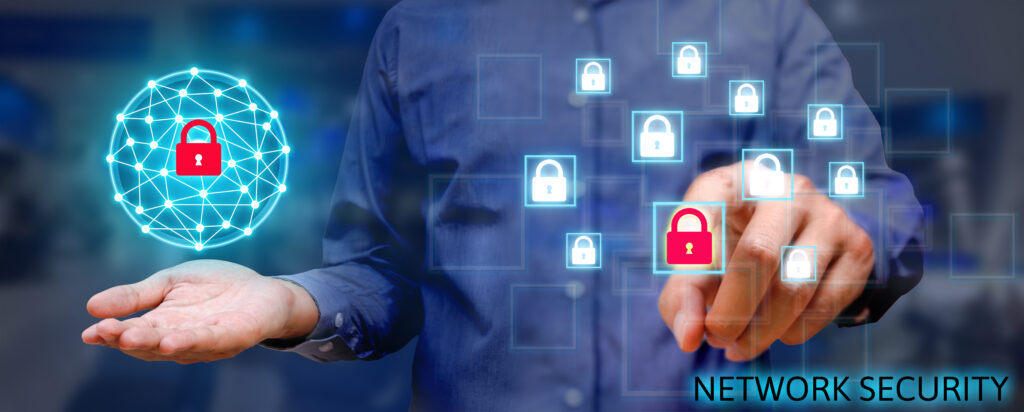INTELLIGENT SECURITY & CYBERSECURITY SOLUTION
designed to prevent or mitigate cyber-attacks
by studying the threat data and provide information on adversaries.
> SERVICES
Expert Cybersecurity Services
Ensure smooth operations and optimal performance
with our comprehensive support and services
Threat Intelligence
Threat Intelligence is the practice of collecting, analyzing, and utilizing information about potential and current threats to enhance an organization’s cybersecurity posture.
Security Assessment
A Security Assessment is a comprehensive evaluation of an organization’s information systems and infrastructure to identify vulnerabilities, threats, and risks.
Compromise Assessment
A Compromise Assessment is a thorough investigation conducted to determine whether an organization’s IT environment has been breached or compromised by malicious actors.
Incident Response
Incident Response (IR) is a structured approach for
handling and managing the aftermath of a security breach or cyberattack.
Cloud Security
Cloud security encompasses the technologies, policies,
controls, and services designed to protect data, applications, and infrastructure in cloud computing environments.
Security Training
Security training involves educating employees about the importance of cybersecurity, potential threats, and best practices to safeguard the organization’s assets.

Protect And Secure
Protect your business with comprehensive cybersecurity solutions
security system design
Designing an effective security system is crucial for protecting an organization’s assets from cyber threats and ensuring compliance with regulatory requirements.
Distribution of Security System, Information Technology & Cybersecurity Products
Effective distribution of security systems, IT, and cybersecurity products requires a well-coordinated approach that includes robust supply chain management, advanced technology integration, and a customer-centric focus.

Your success and security are our priorities.
Frequently Asked Questions
Common Cybersecurity Threats.
Cybersecurity threats are malicious activities aimed at compromising the integrity, confidentiality, or availability of an organization’s data and systems. Understanding these threats and implementing effective prevention strategies is crucial for protecting organizational assets.
Common Cybersecurity Threats
- Phishing: Deceptive attempts to obtain sensitive information by masquerading as a trustworthy entity via email or other communication channels.
- Malware: Malicious software designed to damage, disrupt, or gain unauthorized access to computer systems. Includes viruses, worms, ransomware, spyware, and trojans.
- Ransomware: A type of malware that encrypts the victim’s data, demanding payment for the decryption key.
- DDoS (Distributed Denial of Service) Attacks: Overwhelming a target system with a flood of internet traffic to make it unavailable to users.
- Man-in-the-Middle (MitM) Attacks: Intercepting and altering communication between two parties without their knowledge.
- SQL Injection: Inserting malicious SQL code into a query to manipulate the database and access unauthorized data.
- Zero-Day Exploits: Attacks that occur on the same day a vulnerability is discovered and before a patch is released.
- Insider Threats: Malicious actions by employees or other insiders who have access to organizational data and systems.
- Credential Theft: Stealing user credentials (usernames and passwords) to gain unauthorized access to systems.
- Advanced Persistent Threats (APTs): Prolonged and targeted cyber attacks aimed at stealing data or disrupting operations.
Common Cybersecurity Prevention.
Preventing cybersecurity threats requires a comprehensive and proactive approach that includes employee training, robust technical controls, regular updates, and continuous monitoring. By understanding common threats and implementing these prevention strategies, organizations can significantly enhance their security posture and reduce the risk of successful cyber attacks. Regular reviews and updates to security policies and technologies are essential to keeping up with the evolving threat landscape.
Prevention Strategies
- Employee Training and Awareness
- Conduct regular cybersecurity training to educate employees about recognizing phishing attempts, social engineering, and other threats.
- Promote awareness of security policies and procedures.
- Robust Authentication Mechanisms
- Implement multi-factor authentication (MFA) to add an extra layer of security beyond passwords.
- Enforce strong password policies, requiring complex and unique passwords.
- Regular Software Updates and Patching
- Ensure all systems, applications, and devices are regularly updated with the latest security patches.
- Use automated patch management tools to streamline the process.
- Network Security Measures
- Deploy firewalls to filter incoming and outgoing traffic and prevent unauthorized access.
- Implement intrusion detection and prevention systems (IDS/IPS) to monitor and block malicious activities.
- Use virtual private networks (VPNs) to secure remote access to the network.
- Endpoint Protection
- Install and maintain antivirus and anti-malware software on all devices.
- Use endpoint detection and response (EDR) solutions to identify and respond to threats in real-time.
- Data Encryption
- Encrypt sensitive data both at rest and in transit to protect it from unauthorized access.
- Use strong encryption standards and manage encryption keys securely.
- Access Control
- Implement role-based access control (RBAC) to ensure that users only have access to the resources necessary for their role.
- Regularly review and update access permissions.
- Backup and Recovery
- Maintain regular backups of critical data and systems to ensure recovery in case of a ransomware attack or data loss.
- Test backup and recovery procedures periodically to ensure their effectiveness.
- Security Monitoring and Incident Response
- Deploy security information and event management (SIEM) systems to monitor and analyze security events in real-time.
- Develop and maintain an incident response plan to quickly respond to and mitigate security incidents.
- Web Application Security
- Use web application firewalls (WAF) to protect against web-based attacks such as SQL injection and cross-site scripting (XSS).
- Conduct regular security testing, including vulnerability assessments and penetration testing.
- Physical Security
- Secure physical access to servers, workstations, and network devices to prevent tampering or theft.
- Use surveillance and access control systems to monitor and restrict physical access.
- Zero Trust Architecture
- Implement a Zero Trust model, where no entity (inside or outside the network) is trusted by default, and verification is required for access.
- Continuously monitor and validate user and device identities.
What Should I Do After a Cyber Attack
Experiencing a cyber attack can be a stressful and disruptive event for individuals and organizations alike. Responding promptly and effectively is crucial to minimize damage, restore operations, and prevent future incidents. Here are the steps you should take after a cyber attack:
Immediate Response
- Containment: Immediately isolate affected systems or devices to prevent the spread of the attack. Disconnect compromised devices from the network and disable any compromised accounts.
- Assessment: Assess the extent of the damage and determine the type of attack (e.g., malware infection, data breach, ransomware). Identify which systems, data, or services have been compromised.
- Communication: Notify key stakeholders, such as IT staff, management, legal counsel, and relevant third parties (e.g., customers, partners) about the cyber attack. Establish clear lines of communication to coordinate response efforts.
- Preservation of Evidence: Preserve evidence of the cyber attack for forensic analysis and potential legal proceedings. Avoid modifying or deleting files or logs that could be critical for investigation.
Mitigation and Recovery
- Incident Response Plan Activation: Implement your organization’s incident response plan (IRP) to guide mitigation and recovery efforts. Follow predefined procedures for containing the attack, restoring services, and recovering data.
- Restore Backup Data: If data has been compromised or encrypted by ransomware, restore systems and data from secure backups. Ensure that backups are recent, verified for integrity, and unaffected by the attack.
- Patch and Update: Apply security patches and updates to affected systems and software to close vulnerabilities exploited in the attack. This helps prevent future incidents leveraging the same vulnerabilities.
- Password Resets: Reset passwords for compromised accounts and enforce strong password policies. Consider implementing multi-factor authentication (MFA) for added security.
- Scan for Malware: Conduct thorough malware scans across all systems to detect and remove any malicious software left behind by the attackers.
- Reconnect Systems: Gradually reconnect systems and devices to the network once they have been cleaned, patched, and verified as secure. Monitor these systems closely for any signs of ongoing malicious activity.
Investigation and Learning
- Root Cause Analysis: Investigate the root cause of the cyber attack to understand how the attackers gained access and what vulnerabilities were exploited. This information is crucial for preventing future incidents.
- Forensic Analysis: Perform forensic analysis of affected systems to gather evidence and identify the extent of data compromise. Work with cybersecurity experts or forensic analysts as needed.
- Legal and Regulatory Obligations: Determine if the cyber attack requires reporting to regulatory authorities or law enforcement, depending on the nature of the incident and applicable laws.
- Review and Update Security Practices: Conduct a comprehensive review of your organization’s security practices, policies, and controls. Identify weaknesses exposed by the attack and implement improvements to strengthen defenses.
- Employee Training: Provide additional cybersecurity training for employees to raise awareness about the attack, reinforce best practices, and help prevent similar incidents in the future.
Communication and Notification
- Internal Communication: Keep employees informed about the cyber attack, its impact, and the steps being taken to address it. Provide guidance on security measures they can take to protect company assets.
- External Communication: If customer or partner data was compromised, communicate transparently with affected parties about the incident, the potential impact on their data, and any steps they should take to protect themselves.
- Public Relations: Manage public relations and reputation management efforts carefully to maintain trust and confidence in your organization’s ability to handle cybersecurity incidents responsibly.
Prevention and Future Readiness
- Implement Security Improvements: Based on lessons learned from the cyber attack, implement recommended security improvements and best practices to strengthen your organization’s defenses against future threats.
- Regular Testing and Monitoring: Schedule regular security assessments, vulnerability scans, penetration testing, and threat hunting exercises to proactively identify and address security weaknesses.
- Update Incident Response Plan: Update your incident response plan based on insights gained from the cyber attack. Ensure it includes procedures for handling different types of incidents and roles/responsibilities are clearly defined.
- Engage with Cybersecurity Experts: Consider engaging with cybersecurity experts or consultants to conduct a thorough security assessment and provide recommendations for enhancing your organization’s cybersecurity posture.
By following these steps after a cyber attack, organizations can mitigate damage, improve resilience against future incidents, and maintain trust with stakeholders. Taking a proactive approach to cybersecurity is essential in today’s digital landscape where threats are constantly evolving.
Benefits of Outsourcing Cybersecurity Services
Outsourcing cybersecurity services can offer several benefits to organizations looking to enhance their security posture and manage cyber risks effectively. Here are some key advantages:
- Access to Specialized Expertise: Cybersecurity service providers often employ highly skilled professionals with expertise in various areas of cybersecurity, such as threat detection, incident response, and compliance. By outsourcing, organizations gain access to this specialized knowledge and experience without the need to hire and train internal staff.
- Cost Efficiency: Outsourcing cybersecurity services can be cost-effective compared to maintaining an in-house cybersecurity team. Organizations can avoid the expenses associated with recruiting, training, and retaining cybersecurity personnel, as well as investing in costly technologies and infrastructure.
- Advanced Technologies and Tools: Cybersecurity service providers typically leverage state-of-the-art technologies, tools, and methodologies to protect their clients’ systems and data. This includes advanced threat intelligence platforms, security monitoring systems (e.g., SIEM), and automated incident response tools that may be too expensive or complex for organizations to implement on their own.
- 24/7 Monitoring and Support: Many cybersecurity service providers offer around-the-clock monitoring of networks and systems for potential threats and vulnerabilities. This continuous monitoring helps detect and respond to security incidents promptly, minimizing the impact of attacks and reducing downtime.
- Focus on Core Business Activities: Outsourcing cybersecurity allows organizations to focus their internal resources and efforts on core business activities and strategic initiatives. It frees up time and resources that would otherwise be spent on managing and maintaining cybersecurity operations.
- Scalability and Flexibility: Cybersecurity needs can fluctuate over time, especially for growing businesses or those undergoing digital transformation. Outsourcing provides scalability, allowing organizations to easily scale up or down their cybersecurity services based on current needs and future growth.
- Compliance and Risk Management: Cybersecurity service providers often have expertise in regulatory requirements and industry standards (e.g., GDPR, HIPAA, PCI-DSS). They can help organizations achieve and maintain compliance, as well as implement effective risk management practices to protect sensitive data and meet legal obligations.
- Rapid Incident Response: In the event of a cybersecurity incident, outsourcing providers can provide rapid incident response services, including containment, investigation, and recovery. Their experience and established procedures can help minimize the impact of the incident and restore normal operations quickly.
- Continuous Improvement and Innovation: Leading cybersecurity service providers invest in research and development to stay ahead of emerging threats and technologies. By outsourcing, organizations can benefit from ongoing improvements and innovations in cybersecurity practices and solutions.
- Risk Transfer: Outsourcing cybersecurity services can also involve transferring some of the risks associated with cyber threats to the service provider. Service level agreements (SLAs) often include provisions for liability and compensation in the event of a security breach, providing added financial protection for organizations.
Overall, outsourcing cybersecurity services can enable organizations to strengthen their defenses, improve resilience against cyber threats, and achieve better overall security outcomes while focusing on their core business objectives. However, it’s crucial for organizations to carefully select reputable and trustworthy service providers and establish clear communication and expectations to maximize the benefits of outsourcing cybersecurity services.


Partner with RTAC for innovative and reliable intelligent security systems, IT products, AI, IoT, robotics, and cybersecurity solutions.
Your success and security are our priorities.
